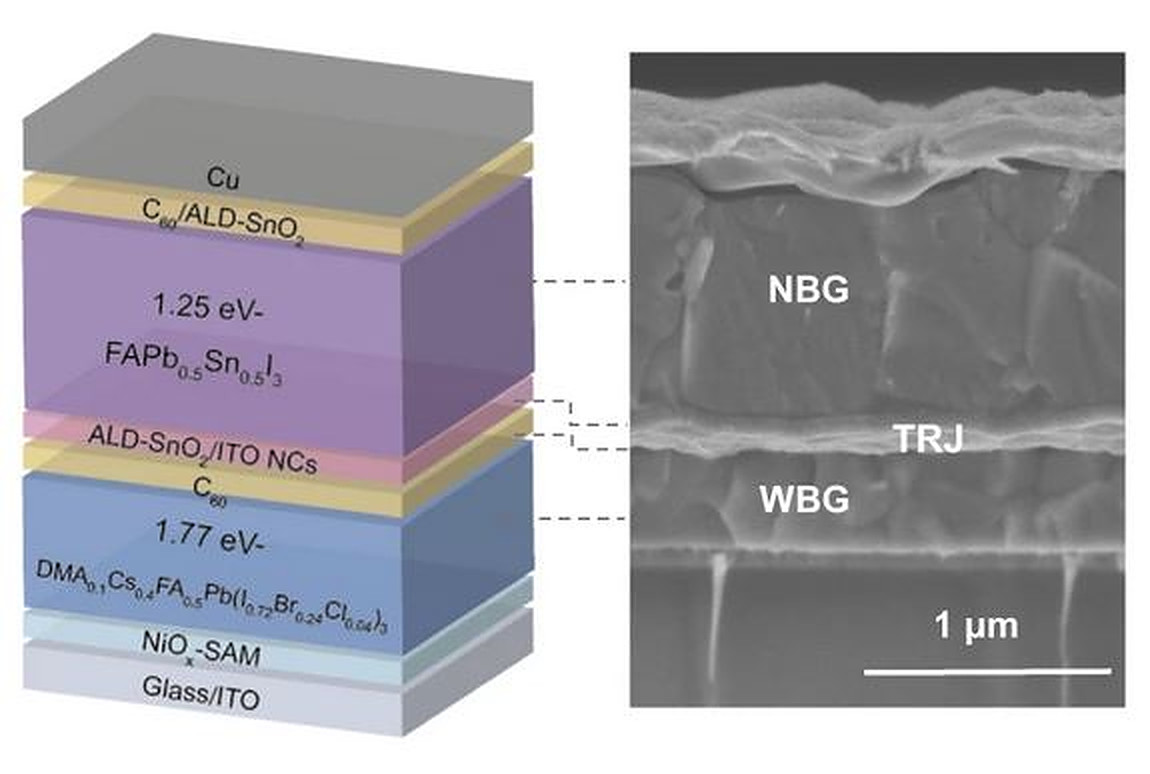A research group from China has developed an all-perovskite tandem solar cell based on a wide bandgap perovskite top cell relying on a two-dimensional/three-dimensional heterostructure and a narrow bandgap bottom cell.
Perovskite cells built with 2D hybrid materials are known for their stability and exhibit large exciton binding energy compared to conventional, 3D devices.
For the fabrication of the top cell, the research group used a generic 3D-to-2D perovskite conversion approach. It first deposited a lead-halide perovskite known as methylammonium lead iodide (MAPbI3) layer by a hybrid evaporation/solution method and then transformed the layer into a 2D structure via a long-chain ammonium ligand.
The device is based on a substrate made of glass and indium tin oxide (ITO), a hole transport layer (HTL) made of nickel(II) oxide (NiOx) and a self-assembled monolayer (SAM), the perovskite absorber, a buckminsterfullerene (C60) electron transport layer, a bathocuproine (BCP) buffer layer, a tin(IV) oxide (SnO2) layer, and a copper (Cu) metal contact.
“The resulting 2D/3D heterostructure effectively accelerates the charge extraction at the perovskite/C60 interface and thereby suppresses light-induced halide segregation,” the researchers explained, noting that this top cell achieved an energy bandgap of 1.78 eV. The device also achieved a power conversion efficiency of 19.6%, an open-circuit voltage of 1.324 V, a short-circuit current density of 17.9 mA cm−2, and a fill factor of 83.0%. It was also able to retain 95% of its original efficiency after 1,000 h.
Popular content
For the construction of the all-perovskite tandem solar cell, the research team also used a 21.3%-efficient bottom perovskite cell based on an ITO substrate, a narrow bandgap perovskite, a C60 electron transport layer, a SnO2 layer, and a Cu metal contact.
The champion device built with this configuration reached an efficiency of 28.1%, an open-circuit voltage of 2.135 V, a short-circuit density of 16.2 mA cm−2, and a fill factor of 81.5%. It also retained 90% of its initial efficiency after 855 h of continuous operation.
They introduced the novel cell tech in the study “Heterojunction formed via 3D-to-2D perovskite conversion for photostable wide-bandgap perovskite solar cells,” published in nature communications. The research group included academics from the Nanjing University and the University of Electronic Science and Technology of China.
“This study notably reveals the degradation mechanism of wide bandgap perovskite devices and proposes an unprecedented technical approach to simultaneously improving efficiency and stability,” they concluded.
This content is protected by copyright and may not be reused. If you want to cooperate with us and would like to reuse some of our content, please contact: editors@pv-magazine.com.



By submitting this form you agree to pv magazine using your data for the purposes of publishing your comment.
Your personal data will only be disclosed or otherwise transmitted to third parties for the purposes of spam filtering or if this is necessary for technical maintenance of the website. Any other transfer to third parties will not take place unless this is justified on the basis of applicable data protection regulations or if pv magazine is legally obliged to do so.
You may revoke this consent at any time with effect for the future, in which case your personal data will be deleted immediately. Otherwise, your data will be deleted if pv magazine has processed your request or the purpose of data storage is fulfilled.
Further information on data privacy can be found in our Data Protection Policy.